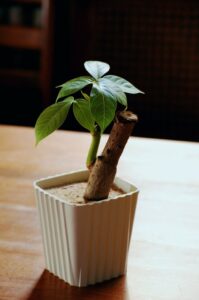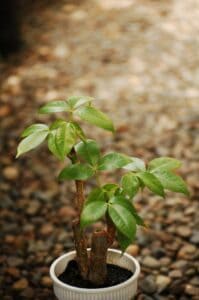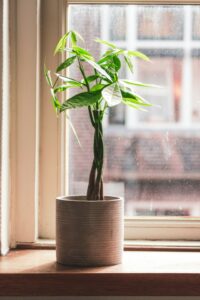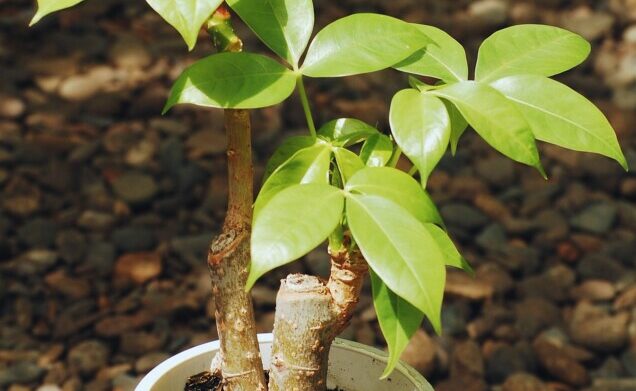Some links in the post are affiliate links and I get a commission from purchases made through some links found in the post.
I can almost remember every detail of that fateful day. I had come home from a three-day break and was eager to show off my plants to my house guest.
We walked around, marveling at the amazing work I had done. Everything was green, blooming, and oozed natural beauty.
That is until we got to my money tree. It stood there, slouching, somehow lifeless, as if my three days away had somehow robbed it of its life.
But I knew that I had watered it to ensure that this did not happen. I had two options at that point.
The first was to pretend that underwatering was the culprit and water it some more. That would have helped me save face.
The second, which was the right thing to do, was to investigate all possible causes and figure out how I could deal with the problem.
The reasons a money tree could be drooping are low humidity, inadequate temperature regulation, poor lighting, overwatering, underwatering and transplant shock.
I chose the second route. And this guide takes you through what could be causing drooping in your money tree and what you can do about it:
Why Are My Money Tree Leaves Drooping?
 Drooping leaves are not the picture of perfect health. And you can find yourself doubting your prowess in gardening.
Drooping leaves are not the picture of perfect health. And you can find yourself doubting your prowess in gardening.
However, drooping leaves are just a sign that something is not right with your money tree. Thus, if you fix what’s wrong, your plant will be fine.
Rather than take the drooping leaves as a sign you have not done right by your plant, take them as the plant’s way of communicating its needs.
What can cause drooping in the money tree? The reasons will interest you:
1) Low Humidity
When the money tree does not have adequate humidity, it reacts physically. You can see it in the form of:
- Browning on the leaf edges,
- Leaf drooping,
- Leaf yellowing, and
- Stunted growth.
The good news is that low humidity cannot kill your plant. However, it hampers the plant’s growth, resulting in stunted and deformed growth, which is not what you had hoped for when buying the money tree.
How to Fix Low Humidity
Low humidity is not an emergency. But the sooner you fix it, the better your plant will look. Ideally, the money tree should be in a highly humid area. And you can create similar conditions by:
- Placing the money tree pot on a tray filled with pebbles and water. Ensure the pot does not sit on the water as this can cause overwatering,
- Misting the plant regularly during the day,
- Using a humidifier,
- Growing the money tree amongst other plants,
- Placing the plant in the kitchen or bathroom where humidity levels are high, or
- Leaving the doors to the kitchen and bathroom open to heighten humidity levels in the home.
These tips should work the magic. I should point out that humidity and temperature are highly correlated. So, as you fix the humidity, pay attention to the temperature range around the plant.
2) Inadequate Temperature Regulation
When temperatures fall, so does the humidity. Thus, while you might work to get the humidity up, it won’t do much good if the temperatures are not optimal.
So, how can your plant show you that the temperatures need some tweaking?
- The leaves and flowers start drooping and falling off,
- Yellowing starts showing on the leaves, and
- The plant’s growth stunts.
These are all signs that the leaves have suffered permanent damage due to low temperatures. Usually, you see such changes when the temperatures fall below 50 degrees Fahrenheit.
It can also happen when you expose the plant to cold drafts by placing it near an air conditioner or window.
But low temperatures are not the only thing to worry about regarding the money tree. Extremely high temperatures can also cause damage to the plant.
They increase the rate of water loss to the environment and can even burn the foliage. In such a case, the plant appears limp with wilting leaves.
How To Fix Temperature Issues
How can you ensure your plant enjoys optimal temperatures throughout the year? Here’s what you do:
- Place the plant in a room where temperatures range between 65- and 75-degrees Fahrenheit,
- Ensure the plant is not in the way of any cold or warm air drafts. It should not be close to heating or cooling vents.
In the winter and summer, you will need to be extra careful with the temperature ranges as they can get out of hand.
Now that we have solved one mystery, let’s deal with another closely related factor that could cause drooping in your money tree – lighting issues.
You may also like: Money Tree vs Money Plant
3) Poor Lighting
Should your plant have direct exposure to the sun, or should you place it in bright but indirect light? Here’s the thing.
While the temperature in the room may not be above 75 degrees Fahrenheit, leaving your money tree exposed to the sun can wreak havoc on its leaves and stem. The plant shows the following signs of distress:
- Drooping of the leaves, and
- Browning on the leaf edge.
The same goes for leaving the plant in poor lighting. The plant shows leggy growth, exhibits stunted growth and starts wilting.
Such a plant can also suffer overwatering because the potting mix does not dry out often.
How To Fix Lighting Issues
Interestingly, the money tree grows in direct sunlight in its natural habitat. But when brought indoors, it does not seem to enjoy this level of exposure.
You should place it in a spot where it can receive bright indirect sunlight for at least 6 hours every day. Ensure the plant does not receive direct sunlight.
And when placing it near a window, protect it from the sun’s rays using a sheer or any other material that can block the direct rays.
If your home does not have access to sufficient lighting, you can always supplement the light with fluorescent lighting. Keep this up, especially in the winter when the lighting is often inadequate to support healthy plant growth.
What do high temperatures and too much lighting affect? – The rate of water loss from the plant. So, what happens when you fix the temperature and lighting such that the transpiration and evaporation rates are optimal?
For more on money tree light requirements we have created a full article to guide you.
In that case, you must also tweak the water you give to the plant. Let’s cover two water-related drooping causes:
4) Overwatering
 When I found my money tree looking limp with drooping leaves, do you remember my first thought? Like most people, I assumed the plant did not have enough water.
When I found my money tree looking limp with drooping leaves, do you remember my first thought? Like most people, I assumed the plant did not have enough water.
After all, plants require water to promote diffusion processes that enable their cells to bulge out, creating that solid effect.
But sometimes, we go overboard with the watering and kill our plants.
That’s right – overwatering is a known plant killer. And to make matters worse, it is a silent killer. It can go unnoticed for so long that the plant has no chance of survival by the time you find out.
So, what causes overwatering?
- Giving the plant water when the soil is already moist,
- Choosing the wrong potting mix for the money tree,
- Using a potting mix with poor drainage, or
- Using a pot that does not have adequate drainage holes.
In such a case, the plant’s roots sit in water. And because the plant already has sufficient water, it cannot absorb more water.
The moisture thus ends up taking up the air pockets in the soil, depriving the plant of oxygen.
Plants need oxygen as much as we do, and without it, the roots start drowning and dying. With dying roots, the plant can barely absorb nutrients and water from the soil. So, it shows distress via:
- Drooping leaves,
- Yellowing of the leaves,
- Edema,
- A funky smell from the soil,
- Mold on the surface,
- Damaged roots with soggy black or brown sections, and
- Browning edges.
It’s pretty hard to notice underwatering in its early stages. These signs start showing when the damage has already begun, and if you do not act fast enough, the plant could die.
How To Fix Overwatering
By the time you notice the above signs, root damage has probably already begun. You need to remove the plant from the pot and inspect its roots.
Do they appear damaged? If not, you can alter your watering schedule and water the plant only when the top layer of soil is dry.
But what if root damage has already started? You will need to:
- Cut off the damaged parts with clean scissors,
- Repot the plant in a money tree potting mix. Ideally, you should use a peat moss-based potting mix as it has adequate nutrients and drainage, and
- Ensure the plant has enough drainage holes at the bottom.
Sometimes, the damage is so severe that you cannot save it. If most or all the root is affected, you are better off starting again at the propagation stage.
if you’re enjoying this article, check out our article on why are my money tree leaves turning yellow.
5) Underwatering
We have finally arrived at what most people think is the cause of drooping leaves. It would make sense that your plant would wilt because it does not have sufficient water flowing through its cells.
And you would be right to think so. So, what causes underwatering?
Plant activities require water. And as they take place, the plant loses moisture to the environment through evaporation and transpiration.
It makes up for this loss by absorbing more water from the soil. But when there is nothing left to absorb and plant processes continue, you can imagine that a deficit occurs. And that’s what we see in the form of:
- Drooping leaves,
- Curling and browning of the leaf edges.
- Yellowing of the leaves, and
- Stunted growth.
All these are signs that the plant does not have adequate water. But remember that these are also closely related to temperature and lighting.
When a plant is in too much light, it also droops and starts showing signs of leaf browning. That’s why you must first begin by assessing the conditions in which the money tree grows before making any significant changes.
How to Fix Underwatering Issues

The first thing you should do is assess the state of the soil. Is the top inch dry? If yes, the plant needs watering. The second thing to evaluate is your watering schedule.
How often do you water the plant, and how do you go about it? The right way to water a money tree is to wait until its top inch of soil is dry.
Then water it thoroughly until excess water drains from the pot. Allow the plant to sit and absorb the water and check in after a few days.
If you are unsure when to water the plant, I recommend getting a moisture gauge. It helps you know when the plant needs water and when it can wait a few more days without more moisture.
Oh, and do not forget to assess the lighting and temperature conditions. They contribute greatly to the transpiration and evaporation processes and could be the culprits behind the significant water losses.
You may also like: Money tree plant problems
6) Transplant Shock
You should repot the money tree if it gets rootbound or if you want it to grow bigger. In each repotting instance, you must use a pot that is one size bigger than the current one.
Sometimes, the money tree does not take too well to the change in environment and can start drooping. Usually, this shows in the first few days after changing its pot.
How to Fix Transplant Shock
The plant is yet to get accustomed to its new home, and there’s not much you can do about it. However, you can provide the right conditions to support its growth.
Pay attention to the watering, lighting, humidity, and temperature conditions. If these are right, the plant should be fine after a few days.
Final Thoughts
So, what was the culprit in my case? It was transplant shock! Before leaving my home, I had moved the money tree to a much bigger pot.
It turned out that the plant had still not gotten accustomed to its new home and was quite distressed.
I gave it a few days, and slowly but surely, the plant came back to life. See? Had I watered it more, I would have overwatered it, which could have killed it.
Before you act, please uncover the underlying cause of the drooping. Happy Gardening!


